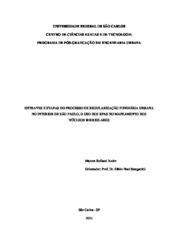| dc.contributor.author | Kolland Junior, Marcos | |
| dc.date.accessioned | 2022-12-06T11:21:32Z | |
| dc.date.available | 2022-12-06T11:21:32Z | |
| dc.date.issued | 2022-08-02 | |
| dc.identifier.citation | KOLLAND JUNIOR, Marcos. Entraves e etapas do processo de regularização fundiária urbana no interior de São Paulo, o uso dos RPAS no mapeamento dos núcleos irregulares. 2022. Dissertação (Mestrado em Engenharia Urbana) – Universidade Federal de São Carlos, São Carlos, 2022. Disponível em: https://repositorio.ufscar.br/handle/ufscar/17122. | * |
| dc.identifier.uri | https://repositorio.ufscar.br/handle/ufscar/17122 | |
| dc.description.abstract | This work is part of a series of studies developed in the Graduate Program in Urban Engineering (PPGEU), the object of study is the practice and development of urban land regularization in Brazil. According to several reports and evidence, in ancient civilizations the use of Cartography was already present as a way of representing and organizing the physical surface of the earth, as well as the important objects and phenomena contained therein, generally with the purpose of carrying out and organizing the development of society as a whole. Approximately half of the Brazilian properties are in an irregular situation, and with the current state of technology, together with the popularization of Remotely Piloted Aircraft, it has been used in a very present way in the organization of the use and occupation of the land by the different spheres of the public and private power. Land tenure regularization is the set of legal, technical, urban, environmental and social measures aimed at the regularization of properties, subdivisions, settlements and the titling of their occupants. This work presents a brief history and synthesis of specific regulations, through the use and development of a methodology where the stages of the land regularization process are divided into ten topics. The process was carried out in a partially irregular subdivision with approximately 4500 lots, where aerophotogrammetric techniques, equipment and software were used together with GNSS receivers to obtain the cartographic products, which were subsidy material for the study and application of REURB-E. The results of the present study conditioned the understanding of the current situation of the subdivision, the classification and quantification of properties, linked to the realization of the REURB project, which, finally, seeks to deliver in a didactic way a guide for carrying out similar engineering activities. | eng |
| dc.description.sponsorship | Coordenação de Aperfeiçoamento de Pessoal de Nível Superior (CAPES) | por |
| dc.language.iso | por | por |
| dc.publisher | Universidade Federal de São Carlos | por |
| dc.rights | Attribution-NonCommercial-NoDerivs 3.0 Brazil | * |
| dc.rights.uri | http://creativecommons.org/licenses/by-nc-nd/3.0/br/ | * |
| dc.subject | RPAS | por |
| dc.subject | Regularização Fundiária | por |
| dc.subject | GNSS | por |
| dc.subject | Aerofotogrametria | por |
| dc.subject | Mapeamento | por |
| dc.subject | Land Regularization | eng |
| dc.subject | Aerophotogrammetry | eng |
| dc.subject | Mapping | eng |
| dc.title | Entraves e etapas do processo de regularização fundiária urbana no interior de São Paulo, o uso dos RPAS no mapeamento dos núcleos irregulares | por |
| dc.title.alternative | Barriers and steps in the process of urban land regularization in the interior of São Paulo, the use of RPAS in the mapping of irregular centers | eng |
| dc.type | Dissertação | por |
| dc.contributor.advisor1 | Stanganini, Fábio Noel | |
| dc.contributor.advisor1Lattes | http://lattes.cnpq.br/6774358264004600 | por |
| dc.description.resumo | Esta dissertação integra uma série de estudos desenvolvidos no Programa de Pós-Graduação em Engenharia Urbana (PPGEU). O objeto de estudo aqui apresentado é focado na prática e desenvolvimento da regularização fundiária urbana no âmbito brasileiro. De acordo com diversos relatos e evidências, nas antigas civilizações já era presente o uso da Cartografia como forma de representar e organizar a superfície física da Terra, bem como os objetos e fenômenos importantes nela contidos, geralmente com a finalidade de realizar e organizar o desenvolvimento da sociedade como um todo. Aproximadamente, metade dos imóveis brasileiros se encontram em situação de irregularidade, e a tecnologia atual, juntamente com a popularização das Aeronaves Remotamente Pilotadas, tem sido empregada de forma muito presente na organização do uso e ocupação do solo pelas diferentes esferas do poder público e privado. A regularização fundiária é o conjunto de medidas jurídicas, técnicas, urbanísticas, ambientais e sociais que visam a regularização de imóveis, loteamentos, assentamentos e à titulação de seus ocupantes. Este trabalho apresenta um breve histórico e síntese das normativas específicas por meio da utilização e desenvolvimento de uma metodologia em que as etapas do processo de regularização fundiária são divididas em dez tópicos. O processo foi realizado em um loteamento parcialmente irregular com aproximadamente 4500 lotes, onde foram utilizados técnicas, equipamentos e softwares aerofotogramétricos em conjunto com receptores GNSS para obtenção dos produtos cartográficos, que foram material de subsídio, para estudo e aplicação da REURB-E. Os resultados do presente estudo condicionaram o entendimento da situação atual do loteamento, da classificação e quantificação das propriedades, atrelado à realização do projeto de REURB que, por fim, busca entregar, de uma forma didática, um guia, para a realização de semelhantes atividades de engenharia. | por |
| dc.publisher.initials | UFSCar | por |
| dc.publisher.program | Programa de Pós-Graduação em Engenharia Urbana - PPGEU | por |
| dc.subject.cnpq | ENGENHARIAS | por |
| dc.description.sponsorshipId | 88887.499208/2020-00 | por |
| dc.publisher.address | Câmpus São Carlos | por |
| dc.contributor.authorlattes | http://lattes.cnpq.br/5998054688443100 | por |


